+ Open data
Open data
- Basic information
Basic information
| Entry | Database: PDB / ID: 6lz9 | |||||||||
|---|---|---|---|---|---|---|---|---|---|---|
| Title | t8E4 antibody Fab complexed with the active form of HGF | |||||||||
 Components Components |
| |||||||||
 Keywords Keywords | IMMUNE SYSTEM / antibody / HGF / hepatocyte growth factor / active form | |||||||||
| Function / homology |  Function and homology information Function and homology informationregulation of p38MAPK cascade / skeletal muscle cell proliferation / regulation of branching involved in salivary gland morphogenesis by mesenchymal-epithelial signaling / Drug-mediated inhibition of MET activation / MET activates STAT3 / negative regulation of hydrogen peroxide-mediated programmed cell death / MET Receptor Activation / MET interacts with TNS proteins / hepatocyte growth factor receptor signaling pathway / MET receptor recycling ...regulation of p38MAPK cascade / skeletal muscle cell proliferation / regulation of branching involved in salivary gland morphogenesis by mesenchymal-epithelial signaling / Drug-mediated inhibition of MET activation / MET activates STAT3 / negative regulation of hydrogen peroxide-mediated programmed cell death / MET Receptor Activation / MET interacts with TNS proteins / hepatocyte growth factor receptor signaling pathway / MET receptor recycling / MET activates PTPN11 / MET activates RAP1 and RAC1 / MET activates PI3K/AKT signaling / MET activates PTK2 signaling / positive regulation of DNA biosynthetic process / cellular response to hepatocyte growth factor stimulus / negative regulation of release of cytochrome c from mitochondria / chemoattractant activity / negative regulation of interleukin-6 production / myoblast proliferation / positive regulation of interleukin-10 production / epithelial to mesenchymal transition / positive regulation of osteoblast differentiation / MET activates RAS signaling / negative regulation of extrinsic apoptotic signaling pathway via death domain receptors / Interleukin-7 signaling / negative regulation of autophagy / platelet alpha granule lumen / epithelial cell proliferation / cell chemotaxis / growth factor activity / liver development / Negative regulation of MET activity / negative regulation of inflammatory response / cell morphogenesis / Constitutive Signaling by Aberrant PI3K in Cancer / Platelet degranulation / PIP3 activates AKT signaling / mitotic cell cycle / PI5P, PP2A and IER3 Regulate PI3K/AKT Signaling / RAF/MAP kinase cascade / Interleukin-4 and Interleukin-13 signaling / positive regulation of phosphatidylinositol 3-kinase/protein kinase B signal transduction / positive regulation of MAPK cascade / positive regulation of cell migration / signaling receptor binding / negative regulation of apoptotic process / positive regulation of transcription by RNA polymerase II / extracellular space / extracellular region / identical protein binding / membrane Similarity search - Function | |||||||||
| Biological species |  Homo sapiens (human) Homo sapiens (human) | |||||||||
| Method |  X-RAY DIFFRACTION / X-RAY DIFFRACTION /  SYNCHROTRON / SYNCHROTRON /  MOLECULAR REPLACEMENT / Resolution: 2.8 Å MOLECULAR REPLACEMENT / Resolution: 2.8 Å | |||||||||
 Authors Authors | Kitago, Y. / Umitsu, M. / Takagi, J. | |||||||||
| Funding support |  Japan, 2items Japan, 2items
| |||||||||
 Citation Citation |  Journal: To Be Published Journal: To Be PublishedTitle: t8E4 antibody Fab complexed with the active form of HGF Authors: Umitsu, M. / Kitago, Y. / Takagi, J. #1: Journal: Sci Rep / Year: 2016 Title: Probing conformational and functional states of human hepatocyte growth factor by a panel of monoclonal antibodies. Authors: Umitsu, M. / Sakai, K. / Ogasawara, S. / Kaneko, M.K. / Asaki, R. / Tamura-Kawakami, K. / Kato, Y. / Matsumoto, K. / Takagi, J. | |||||||||
| History |
|
- Structure visualization
Structure visualization
| Structure viewer | Molecule:  Molmil Molmil Jmol/JSmol Jmol/JSmol |
|---|
- Downloads & links
Downloads & links
- Download
Download
| PDBx/mmCIF format |  6lz9.cif.gz 6lz9.cif.gz | 315.6 KB | Display |  PDBx/mmCIF format PDBx/mmCIF format |
|---|---|---|---|---|
| PDB format |  pdb6lz9.ent.gz pdb6lz9.ent.gz | 214.9 KB | Display |  PDB format PDB format |
| PDBx/mmJSON format |  6lz9.json.gz 6lz9.json.gz | Tree view |  PDBx/mmJSON format PDBx/mmJSON format | |
| Others |  Other downloads Other downloads |
-Validation report
| Summary document |  6lz9_validation.pdf.gz 6lz9_validation.pdf.gz | 463.5 KB | Display |  wwPDB validaton report wwPDB validaton report |
|---|---|---|---|---|
| Full document |  6lz9_full_validation.pdf.gz 6lz9_full_validation.pdf.gz | 472.5 KB | Display | |
| Data in XML |  6lz9_validation.xml.gz 6lz9_validation.xml.gz | 24.8 KB | Display | |
| Data in CIF |  6lz9_validation.cif.gz 6lz9_validation.cif.gz | 33.5 KB | Display | |
| Arichive directory |  https://data.pdbj.org/pub/pdb/validation_reports/lz/6lz9 https://data.pdbj.org/pub/pdb/validation_reports/lz/6lz9 ftp://data.pdbj.org/pub/pdb/validation_reports/lz/6lz9 ftp://data.pdbj.org/pub/pdb/validation_reports/lz/6lz9 | HTTPS FTP |
-Related structure data
- Links
Links
- Assembly
Assembly
| Deposited unit | 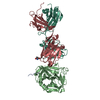
| ||||||||||||
|---|---|---|---|---|---|---|---|---|---|---|---|---|---|
| 1 |
| ||||||||||||
| Unit cell |
|
- Components
Components
| #1: Protein | Mass: 12280.603 Da / Num. of mol.: 1 / Fragment: K4 domain / Mutation: N402Q, T476G, K491I, Q492E, L493G Source method: isolated from a genetically manipulated source Details: This molecule was produced as one polypeptide with chain B, and this chain if N-terminal portion. After the artificial enzymatic cleavage with Factor Xa, they are connected with each other by a disulfide bond. Source: (gene. exp.)  Homo sapiens (human) / Gene: HGF, HPTA / Cell line (production host): Expi293F / Production host: Homo sapiens (human) / Gene: HGF, HPTA / Cell line (production host): Expi293F / Production host:  Homo sapiens (human) / References: UniProt: P14210 Homo sapiens (human) / References: UniProt: P14210 |
|---|---|
| #2: Protein | Mass: 27107.373 Da / Num. of mol.: 1 / Fragment: SP domain / Mutation: C561S, N566Q, N653Q Source method: isolated from a genetically manipulated source Details: This molecule was produced as one polypeptide with chain A, and this chain if C-terminal portion. After the artificial enzymatic cleavage with Factor Xa, they are connected with each other by a disulfide bond. Source: (gene. exp.)  Homo sapiens (human) / Gene: HGF, HPTA / Cell line (production host): Expi293F / Production host: Homo sapiens (human) / Gene: HGF, HPTA / Cell line (production host): Expi293F / Production host:  Homo sapiens (human) / References: UniProt: P14210 Homo sapiens (human) / References: UniProt: P14210 |
| #3: Antibody | Mass: 24075.049 Da / Num. of mol.: 1 Source method: isolated from a genetically manipulated source Details: PCA residue at the N-terminus is the self-cyclized Gln residue. Source: (gene. exp.)  |
| #4: Antibody | Mass: 23847.162 Da / Num. of mol.: 1 Source method: isolated from a genetically manipulated source Source: (gene. exp.)  |
| #5: Water | ChemComp-HOH / |
| Has ligand of interest | N |
| Has protein modification | Y |
-Experimental details
-Experiment
| Experiment | Method:  X-RAY DIFFRACTION / Number of used crystals: 1 X-RAY DIFFRACTION / Number of used crystals: 1 |
|---|
- Sample preparation
Sample preparation
| Crystal | Density Matthews: 3.15 Å3/Da / Density % sol: 61.01 % |
|---|---|
| Crystal grow | Temperature: 293 K / Method: vapor diffusion, sitting drop / pH: 6.5 Details: 10 % (w/v) PEG 10000, 0.1M Magnesium acetate, 0.1M MES pH 6.5 |
-Data collection
| Diffraction | Mean temperature: 100 K / Ambient temp details: 100 / Serial crystal experiment: N |
|---|---|
| Diffraction source | Source:  SYNCHROTRON / Site: SYNCHROTRON / Site:  SPring-8 SPring-8  / Beamline: BL41XU / Wavelength: 1 Å / Beamline: BL41XU / Wavelength: 1 Å |
| Detector | Type: DECTRIS PILATUS3 6M / Detector: PIXEL / Date: Oct 27, 2015 |
| Radiation | Protocol: SINGLE WAVELENGTH / Monochromatic (M) / Laue (L): M / Scattering type: x-ray |
| Radiation wavelength | Wavelength: 1 Å / Relative weight: 1 |
| Reflection | Resolution: 2.8→50 Å / Num. obs: 28218 / % possible obs: 99.7 % / Redundancy: 9.9 % / Biso Wilson estimate: 72.92 Å2 / CC1/2: 0.998 / Net I/σ(I): 13.8 |
| Reflection shell | Resolution: 2.8→2.97 Å / Num. unique obs: 4412 / CC1/2: 0.673 |
- Processing
Processing
| Software |
| |||||||||||||||||||||||||||||||||||||||||||||||||||||||||||||||||||||||||||||
|---|---|---|---|---|---|---|---|---|---|---|---|---|---|---|---|---|---|---|---|---|---|---|---|---|---|---|---|---|---|---|---|---|---|---|---|---|---|---|---|---|---|---|---|---|---|---|---|---|---|---|---|---|---|---|---|---|---|---|---|---|---|---|---|---|---|---|---|---|---|---|---|---|---|---|---|---|---|---|
| Refinement | Method to determine structure:  MOLECULAR REPLACEMENT MOLECULAR REPLACEMENTStarting model: 1SHY, 1OPG Resolution: 2.8→47.87 Å / SU ML: 0.5316 / Cross valid method: FREE R-VALUE / σ(F): 1.35 / Phase error: 35.986 Stereochemistry target values: GeoStd + Monomer Library + CDL v1.2
| |||||||||||||||||||||||||||||||||||||||||||||||||||||||||||||||||||||||||||||
| Solvent computation | Shrinkage radii: 0.9 Å / VDW probe radii: 1.11 Å / Solvent model: FLAT BULK SOLVENT MODEL | |||||||||||||||||||||||||||||||||||||||||||||||||||||||||||||||||||||||||||||
| Displacement parameters | Biso mean: 78.66 Å2 | |||||||||||||||||||||||||||||||||||||||||||||||||||||||||||||||||||||||||||||
| Refinement step | Cycle: LAST / Resolution: 2.8→47.87 Å
| |||||||||||||||||||||||||||||||||||||||||||||||||||||||||||||||||||||||||||||
| Refine LS restraints |
| |||||||||||||||||||||||||||||||||||||||||||||||||||||||||||||||||||||||||||||
| LS refinement shell |
| |||||||||||||||||||||||||||||||||||||||||||||||||||||||||||||||||||||||||||||
| Refinement TLS params. | Method: refined / Origin x: 29.1260065328 Å / Origin y: 63.1646002203 Å / Origin z: 32.4677032777 Å
| |||||||||||||||||||||||||||||||||||||||||||||||||||||||||||||||||||||||||||||
| Refinement TLS group | Selection details: all |
 Movie
Movie Controller
Controller




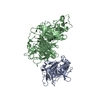
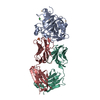
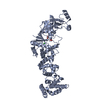

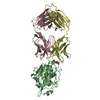
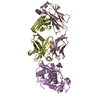

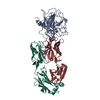
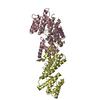
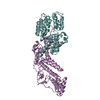
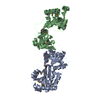
 PDBj
PDBj










